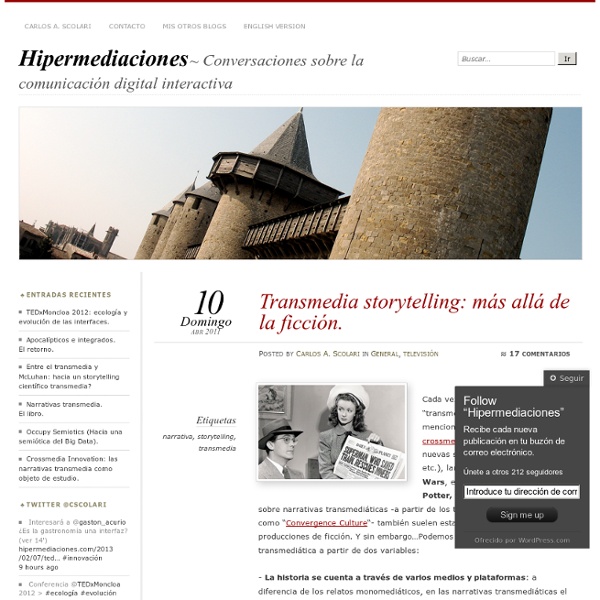"Cenicienta 2.0": entiende el concepto de Narrativa Transmedia en unos minutos (vídeo)
En mi último artículo os hablé del vídeo de Dani Calabuig de Draft FCB en #FOA2013. Lo mejor que he visto para explicar de forma clara y concisa cómo una marca puede beneficiarse de contar historias en un contexto transmedia. Pues aquí lo tenéis, cortesía de Pablo Muñoz, a quien le agradezco la generosidad de compartirlo con todos los lectores de este blog. Me parecen muy acertados: La visión de cómo se integran los consumidores en el proceso.El solapamiento de "ficción" y "realidad". La suma es un contenido que el consumidor sí quiere en sus vidas, hasta el punto de que participa activamente en él. Actualmente estamos trabajando en un contenido Transmedia parecidísimo a esto en Pop up Música. Próximamente más...
Game Design Advance › Turn Me On, Dead Man: Why Urban Legends Make the Best ARGs
In 1969, whispers of a strange rumor began spreading through college newspapers and radio stations across North America. Students in Iowa and Michigan had been tracking clues that pointed towards a sinister conspiracy dating back three years, that if true would suggest one of the most disturbing hoaxes ever staged. Though the mainstream media refused to take their claims seriously, they put their word out in broadcasts, reviews and books, in the hopes of spreading the news and letting everyone in the world know the terrible truth of an entire generation’s greatest heroes. Though that information is still widely written off, it is known in every corner of the earth today by three infamous words: “Paul is dead.” Was it true? See how Paul has his back turned on the back of the Sgt. However, more interesting than the mere narrative of the legend is the fact that it’s been actively perpetrated over the years.
Producing Transmedia Stories – 10 Reasons why Audiences do it Better…
…than Agencies and Filmmakers. Why do transmedia professionals have a difficult time achieving authentic and fluid transmedia stories and why do ‘existing’ branded entertainment & digital agencies tend towards lowest common denominator, tried and tested formulaic cross media, more about PR, advertising and marketing than real ‘story’ focused engagement. Against this and rather paradoxically we have the ‘so-called’ audience/users actually telling their ‘life’ stories across platforms in a much more natural and engaging way. Having produced and studied cross media since 1997 (“What do Audiences Want” BBC pres) one very large and persistent problem has always been creating authentic transmedia stories – natural story arcs and bridges that lead you onward through a long format, multi platform experience. note: this is a personal/user POV condensed version of a longer chapter intro section in my wip book Networked Media Storytelling: Transmedia Design and Production. 2 Authenticity & Trust
Transmedia Storytelling 101
I designed this handout on transmedia storytelling to distribute to my students. More recently, I passed it out at a teaching workshop at the Society for Cinema and Media Studies. I thought it might be of value to more of you out there in the community. For those who want to dig deeper still into this concept, check out the webcast version of the Transmedia Entertainment panel from the Futures of Entertainment Conference. Transmedia Storytelling 101 1. 2. 3. 4. 5. 6. 7. 8. 9. 10.
The Who’s Who of Transmedia | Transmedia Storytelling (Fall 2010)
The main characters in Doctor Who don't change every episode, but this isn't necessarily wrong. Just look at Star Trek for an example of a show that doesn't require character development to be good or engaging. While all of the Dr. Who storytelling outlets were appealing in their own way, I found the radio program to be the least engaging. The other forms of Dr. The comic book version didn’t catch my interest nearly as much as the stories that featured moving pictures. I certainly think it’s possible to stitch together a coherent narrative across multiple mediums; Doctor Who stands as a testament to this. The stories also feature similar structure in terms of characters. Doctor Who seems to consistently meet McKee’s requirement for a good scene: that a binary characteristic of a character is reversed. Like this: Like Loading... Junior at Trinity University.
25 Things You Should Know About Transmedia Storytelling
Let’s get this out of the way, now — this, like many/most of my other lists, could easily be called “25 Things I Think About Transmedia.” It does not attempt to purport concrete truths but rather, the things I believe about the subject at hand. I am something of an acolyte and practitioner in the transmedia cult, and sometimes give talks on the subject (as I will be doing next week in Los Angeles). So, here I am, putting my transmedia ducks in a row. Please to enjoy. 1. The current and straightest-forwardest (not a word) definition of transmedia is when you take a single story or storyworld and break it apart like hard toffee so that each of its pieces can live across multiple formats. 2. Transmedia is, admittedly, kind of a buzz-word. 3. The rise of any new or altered media form sees an awkward transitional period where everyone wants to define it. 4. Good storytelling is still good storytelling. 5. Transmedia these days is strongly marketing-centric. 6. 7. 8. 9. 10. 11. 12. 13. 14. 15.



